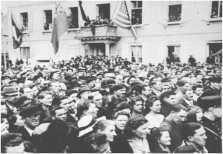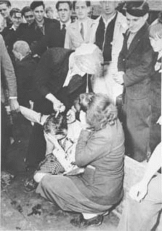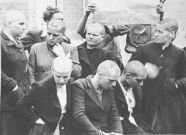The Bitter Road to Freedom: The Human Cost of Allied Victory in World War II Europe (8 page)
Read The Bitter Road to Freedom: The Human Cost of Allied Victory in World War II Europe Online
Authors: William I. Hitchcock
first tasks was the “procurement of civilian labor for grave digging…and the disposition of cattle killed during combat activities.”
52
Cherbourg, liberated by the Americans on June 27, of- fers an excellent example of the convergence of think- ing between the French and Americans. Civil Affairs Detachment A1A1 of the U.S. Army VII Corps quickly went to work with the city mayor and other French of- ficials who “were all at their posts” and gave “whole- hearted cooperation to the detachment.” Although the port facilities had been wrecked by the Germans, the American engineers got quickly to work to prepare the quays to receive off-loaded military supplies. An- other daunting problem was the state of public health. The Civil Affairs medical officers found sanitation in the city to be “deplorable,” lacking basics like potable water and adequate sewage. The American soldiers in the city “made it worse by indiscriminate dumping” of their trash, which added to “a fly nuisance and a rat nuisance.” The hospital facilities used by the Germans were, by the time the Americans arrived, in a disas- trous state: “same old story,” according to Major Harry Tousley of the 298th General Hospital in Cherbourg: “toilets flooded with crap, no water, cockroaches black on the walls and floors.”
53
The Civil Affairs team re- stored power to the water pumping system by July 3.
The enormous stocks of food that the German garri- son had piled up in Cherbourg were duly distributed. Civil Affairs got the local cinema opened up, put out a newspaper, and even launched Radio Cherbourg. Civil Affairs officers helped arrange the resumption of train service, obtained coal to run the power plants, orga- nized road traffic, seized motorized transport, assured adequate supply of French currency in circulation, and tried to restore telephone service. Of course, they also imposed controls and restrictions on civilian life, such as blackouts, curfews, travel passes, and limits on telephone usage, all of which prompted the frequent complaint that the Americans were far more interfer- ing than the Germans had been. But such friction was inevitable. Cherbourg was being refitted to serve as a major supply and transport base to funnel goods from the port to the armies in the field, and in this effort, the Civil Affairs officers needed and found partners among the French authorities who themselves were eager to restore order. Civil Affairs men acted as a spark to revive the confidence of local authorities and “galvanized into action all available Municipal Services and Prefectural Services” by identifying and gathering judges, teach- ers, administrators, and town officials and providing them the tools to govern. A British Civil Affairs official felt that after forty-eight hours, the detachment could have left Cherbourg altogether, so well had French au-
thority been reestablished.
54
* * *
I
S THERE MORE to be said, however, about the na- ture of the order that French and Allied authorities imposed on liberated Normandy? The events of July
14, 1944, in Cherbourg, offer intriguing hints of the var- ious ways order could be imposed on liberated space.
On that day, July 14, Bastille Day, and France’s national holiday, Allied and French military and civilian officials arranged for a handsome public ceremony designed to consecrate the alliance and the transfer of power from Vichy to Gaullist France. According to the Ameri- can commander of the Civil Affairs unit who was pres- ent at the ceremony, “salvos of artillery and ringing of church bells took place at intervals during the day. In the afternoon a big parade assembled in the Place Na- poléon made up of French military, naval and civilian services, US Army units and British RAF and Army. This parade marched to the public garden to [pay respects at] the Memorial of the Dead. It was accompanied by
M. François Coulet [the political representative of the Free French], Admiral Georges Thierry d’Argenlieu, and all the notables of the city.” These Frenchmen were presented by the Allied soldiers with hastily made na-
tional flags that the soldiers had sewn from the cloth of parachutes. “Next on the program was the renaming of the Place Pétain [Cherbourg’s town square] to Place Général de Gaulle”—a symbolic gesture to indicate the clear break with France’s wartime past. There followed a public concert on the square that featured “many of the old songs and tunes of France which had been pro- hibited for four years.”
55
The people of the city turned out in large numbers, waving hats and singing with all the pent-up gusto that a liberated people naturally felt after such a prolonged period of bondage.

Not far from these official celebrations on July 14, at precisely the same time, another kind of public cer- emony was unfolding. About twelve women, publicly accused of consorting with the German occupiers, were dragged into a public square, where they were harangued by a number of self-appointed judges from Resistance groups. Then their hair was shaved off, as smirking young men gazed on with evident satisfac- tion. The women were placed into the back of a truck and paraded through the town, under a sign that read “ The Collaborationist Wagon.” As the truck rolled through the streets of the town, a man sat on the cab of the truck, beating a drum to call attention to these shorn captives.
The public shearing of adulterous women in this man- ner was an ancient tradition, though kept alive more in folklore than in practice. The Resistance members had whispered such threats to the French girlfriends of German soldiers during the war and now they made good on the threat. These women had, according to their persecutors, smiled gaily as they paraded down the streets arm in arm with their foreign masters; now their world was to be turned upside down. Their treachery had been public; their humiliation too would be put on display. Such was the power of the ceremony that it was repeated across liberated France in August
and September: as historian Fabrice Virgili has shown, in the summer of ‘44, some twenty thousand French women felt the cold steel of the shears slice across their scalps, and watched as their tangled locks fell at their feet.
56

July 14, 1944. U.S. National Archives
In a public square renamed for the conservative Cath- olic nationalist General Charles de Gaulle, American and French officials asserted their claim to shape the political order. In the back of a truck, amidst tears and curls, Cherbourg’s men and boys asserted their claim to shape the social order. French women who had once used access to Germans as a form of social power were made once again subservient to French men. The new order was marked out in public, on the bodies of these unfortunate women. Both ceremonies occurred on the first postliberation Bastille Day in the first liberated city in the country.

The new order in liberated Normandy also reflected racial prejudices both of the local French people and of the liberating American army. After the bulk of the Allied combat units left Normandy, on their way to Bel- gium and Germany, the Americans established large supply operations in Cherbourg, on the Normandy beachheads, and in Le Havre, and linked these supply bases via road to the front lines. This was an enormous operation that grew steadily during the fall of 1944 right until the end of the war. Most of the materiel shipped to Normandy from Britain and the United States was loaded onto trucks and transported across northern France to Paris, Brussels, Liège, and on to the front. This logistical supply effort fell onto the shoulders of support troops, many of whom were African-American soldiers who were generally barred from combat duty. In the famous Red Ball Express, the trucking route that ran from Saint-Lô to the front lines, many of the driv- ers—as many as 70 percent in some trucking units— were African-American, and were in frequent contact with local French civilians.
57
Calvados was, politically and socially, a conservative region of France; it was also rural, distant from any major city, and had little contact with people of Afri- can descent. The evidence from the Calvados archives suggests that French civilians, and certainly the French
police, found the presence of African-American sol- diers in their community unsettling. Indeed, the Calva- dos police reports reveal anxiety not only about black soldiers of the U.S. Army, but about North African sol- diers in the French army, who were also being used as support troops in Normandy. French people of rural Calvados would have perceived black and North Afri- can men as exotic and foreign, normally visible only as colonial subjects. But French preconceptions of these men of color as exotic strangers were surely reinforced by the way the U.S. Army treated its own black soldiers. French officials observed American racial prejudice on display in liberated Normandy in the division of labor that relegated black servicemen to subordinate roles and segregated them from whites. This atmosphere of racial tension and hostility that emanated from both American and French authorities became a common point of understanding for those officials charged with creating “order” in Normandy. This mutually reinforc- ing view of an appropriate racial order had grave con- sequences when local French and American authorities addressed questions of law, order, and punishment.
U.S. Army soldiers, black and white, who were in rear support units, and far from the imminent danger of the battle lines, tended to misbehave in ways that ranged from the predictable—carousing, drunkenness, shout-
ing at women, and so on—to the brutal and revolt- ing, including robbery, sexual assault, gang rapes, and murder. However, African-American troops were more frequently punished for these acts than whites. Evidence from U.S. Army records shows conclusively that although blacks were a small statistical minority of U.S. troops in the European Theater—less than 10 percent—they were targeted, by French and American authorities alike, as the scapegoats for widespread American misbehavior and sexual violence. Black American soldiers were charged and convicted and punished for crimes against French people in numbers vastly disproportionate to their statistical presence in the American Army. White soldiers, by contrast, were far less likely to be the subject of official scrutiny and punishment.
The monthly French police reports that local authori- ties compiled invariably described official French-Al- lied relations as “correct and cordial.” Yet exceptions to such cordiality always, in local police reports, in- volved alleged misbehavior of black troops. Does this mean that white soldiers behaved well while black sol- diers did not? No—the Army’s own records show plain- ly that white soldiers repeatedly were brought up on charges of all kinds. Rather, local French sources show that the comportment of black soldiers was monitored